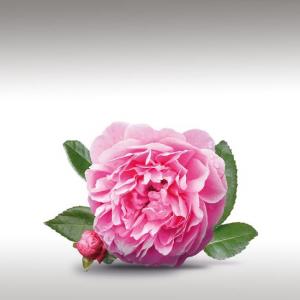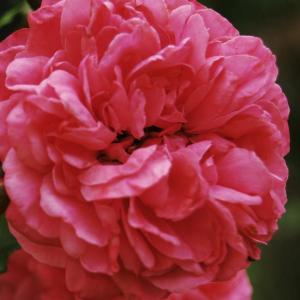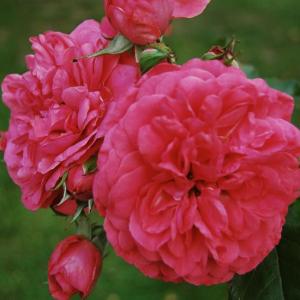
DAMASK ROSE DISTILLATE (ROSA DAMASCENA) - HERBAL DISTILLATES

BASE / GENERAL DATA
Information submited: March 13, 2014 Modified: June 18, 2018 By: OperaDreamhouse
According to Indian legend, the palace gardens belonging to the Mughal Emperor Jahangir featured canals that flowed with Rose Water. One day, his favorite sultana requested that the foam that floated in the canals be removed. The foam gave off the most incomparablefragrance, and the sultana thought it was the most intoxicating scent she had ever smelled. Thus Rose Distillation was born.
Rosa Damascena, more commonly known as the Damask Rose, or sometimes as the Rose of Castile, is a Rose hybrid, derived from Rosa Gallica and Rosa Moschata. Further DNA analysis has shown that a third species, Rosa Fedtschenkoana, is associated with the Damask Rose.
Rosa Damascena is a cultivated flower, no longer found growing wild, and the history of just where it came from is varied, but generally understood as coming from the Middle East.
The Crusader Robert de Brie is sometimes given credit for bringing the Damask Rose from Syria to Europe sometime between 1254 and 1276. The name refers to Damascus, Syria a major city in the Middle Eastern region.
Rosa Damascena, more commonly known as the Damask Rose, or sometimes as the Rose of Castile, is a Rose hybrid, derived from Rosa Gallica and Rosa Moschata. Further DNA analysis has shown that a third species, Rosa Fedtschenkoana, is associated with the Damask Rose.
Rosa Damascena is a cultivated flower, no longer found growing wild, and the history of just where it came from is varied, but generally understood as coming from the Middle East.
The Crusader Robert de Brie is sometimes given credit for bringing the Damask Rose from Syria to Europe sometime between 1254 and 1276. The name refers to Damascus, Syria a major city in the Middle Eastern region.
Other stories say the Romans brought the Rose to England, and a third account says that the physician of Henry VIII gave him a Damask Rose, as a present, around 1540.
The Damask Rose is a deciduous shrub growing to 2,2 metres tall, the stems densely armed with stout, curved prickles and stiff bristles. The Roses are a light to moderate pink to light red. The relatively small flowers grow in groups. The bush has an informal shape.
Gathering the flowers is quite labor - intensive as it must be done by hand. There are about twenty to forty days per year when harvesting occurs, depending on the type of Rosa Damascena cultivation in the region. The Roses are gathered by hand and brought to a central location for steam distillation.
The largest producers of Rose oil from the different names all falling under the name Rosa Damascena are Bulgaria and Turkey. France and India also contribute significantly to the world market. Morocco, Tunisia and some other Middle Eastern countries have historically produced Rose oil, but their modern contribution is minimal.
The town of Kazanlak in Bulgaria was founded in 1420. It is assumed by most historians that the cultivation of the Kazanlak Rose began around that period. Kazanlak called the “Valley of Roses". The distillate from these Roses is sold as "Bulgarian Rose Oil”, and “Bulgarian Rose Otto”. A nearby valley provided the perfect environment for growing Roses, thereby establishing what would in later years become the finest Rose oil producing region in the world.
In Bulgaria, the rose blossoms of Rosa Damascena begin to bloom around the third week of May, and will continue for three or four weeks depending upon climatic conditions. The concentration of perfume and constituents is at its greatest just as the flowers develop into full bloom, it is at this point when it is best to harvest. The expanded flowers should be gathered before sunrise and with the calyx attached so as to gain the maximum amount of volatile oils.
In Bulgaria during the early 1900's, virtually all Rose oil was distilled on-site using direct-fire stills operated by the farmers. A suitable site would be chosen adjacent to the field and near a stream and the apparatus would be set up.
Bulgaria region distillation method:
Once the Rose petals are gathered for the day, they are laid out for a group of women to sift through, taking out any leaves, ensuring that only the Rose Petals go into the stills. Once the correct amount of Rose Petals is placed into the still, pure mountain stream Water is added, three parts by weight of Water to one part of Roses. Then the mixture is gently boiled for four hours as steam is passed off and condensed into another container, as Rose Water.
Modern stills are made of copper and are heated with an open wood fire from below. The Roses can not be distilled in the usual way by directly injecting steam, because the petals compact to form a large mass that the steam can not penetrate. Therefore the distillation techniques have been refined in various ways to overcome this problem.
During distillation a large amount of oil is absorbed into the distillation Water, and this is known as the "First Water". The Rose oil must be recovered from this water to produce an acceptable yield, and this is achieved by skilfully re - distilling the water to separate the oil, a process known as cohobation.
The total yield of oil will depend upon several conditions: climate, the time of the harvest, condition of the flowers and the method of distillation. During the middle of the harvest period the yield is higher than at the beginning, and mild weather will result in a further increase in the oil produced.
On average, Rosa Damascena will yield 1 kilo of oil per 4,000 kilos of flowers using modern distillation processes.
For centuries, the Damascus Rose (Rosa Damascena) has been considered a symbol of beauty and love. The fragrance of the rose has been captured and preserved in the form of rose water by a method that can be traced back to ancient times in the Middle East, and later to the Indian subcontinent. A Persian scientist, Avicenna, is credited with the invention of the process for extracting rose water from rose petals in the early 11th century.
Rose Water preceded the discovery of rose oil and was used for centuries before the oil or "attar" was first produced.
The exact origin of Rose Water and Rose oil production was never recorded in history. However, the existence of Rose Water as far back as 1200 BC to the Mycenaean city of Pilos where it was traded commercially. The production of Rose Water was also a thriving industry in Shiraz in Persia. From 810 BC the province of Faristan in Persia was required to give an annual tribute of 30,000 bottles of Rose Water to the Caliph in Baghdad. At this time Faristan was the centre of global Rose Water production, exporting to China and throughout the Islamic world.
Today there are four main centres in the world where Roses are grown for the production of Rose Water and Rose oil. They are Kazanluk, known as "The Valley of Roses" in Bulgaria, Isparta in Turkey, Shiraz in Iran and Grasse in the South of France. Each of these regions has its own particular climate and process of distillation.
The Damask Rose is a deciduous shrub growing to 2,2 metres tall, the stems densely armed with stout, curved prickles and stiff bristles. The Roses are a light to moderate pink to light red. The relatively small flowers grow in groups. The bush has an informal shape.
Gathering the flowers is quite labor - intensive as it must be done by hand. There are about twenty to forty days per year when harvesting occurs, depending on the type of Rosa Damascena cultivation in the region. The Roses are gathered by hand and brought to a central location for steam distillation.
The largest producers of Rose oil from the different names all falling under the name Rosa Damascena are Bulgaria and Turkey. France and India also contribute significantly to the world market. Morocco, Tunisia and some other Middle Eastern countries have historically produced Rose oil, but their modern contribution is minimal.
The town of Kazanlak in Bulgaria was founded in 1420. It is assumed by most historians that the cultivation of the Kazanlak Rose began around that period. Kazanlak called the “Valley of Roses". The distillate from these Roses is sold as "Bulgarian Rose Oil”, and “Bulgarian Rose Otto”. A nearby valley provided the perfect environment for growing Roses, thereby establishing what would in later years become the finest Rose oil producing region in the world.
In Bulgaria, the rose blossoms of Rosa Damascena begin to bloom around the third week of May, and will continue for three or four weeks depending upon climatic conditions. The concentration of perfume and constituents is at its greatest just as the flowers develop into full bloom, it is at this point when it is best to harvest. The expanded flowers should be gathered before sunrise and with the calyx attached so as to gain the maximum amount of volatile oils.
In Bulgaria during the early 1900's, virtually all Rose oil was distilled on-site using direct-fire stills operated by the farmers. A suitable site would be chosen adjacent to the field and near a stream and the apparatus would be set up.
Bulgaria region distillation method:
Once the Rose petals are gathered for the day, they are laid out for a group of women to sift through, taking out any leaves, ensuring that only the Rose Petals go into the stills. Once the correct amount of Rose Petals is placed into the still, pure mountain stream Water is added, three parts by weight of Water to one part of Roses. Then the mixture is gently boiled for four hours as steam is passed off and condensed into another container, as Rose Water.
Modern stills are made of copper and are heated with an open wood fire from below. The Roses can not be distilled in the usual way by directly injecting steam, because the petals compact to form a large mass that the steam can not penetrate. Therefore the distillation techniques have been refined in various ways to overcome this problem.
During distillation a large amount of oil is absorbed into the distillation Water, and this is known as the "First Water". The Rose oil must be recovered from this water to produce an acceptable yield, and this is achieved by skilfully re - distilling the water to separate the oil, a process known as cohobation.
The total yield of oil will depend upon several conditions: climate, the time of the harvest, condition of the flowers and the method of distillation. During the middle of the harvest period the yield is higher than at the beginning, and mild weather will result in a further increase in the oil produced.
On average, Rosa Damascena will yield 1 kilo of oil per 4,000 kilos of flowers using modern distillation processes.
For centuries, the Damascus Rose (Rosa Damascena) has been considered a symbol of beauty and love. The fragrance of the rose has been captured and preserved in the form of rose water by a method that can be traced back to ancient times in the Middle East, and later to the Indian subcontinent. A Persian scientist, Avicenna, is credited with the invention of the process for extracting rose water from rose petals in the early 11th century.
Rose Water preceded the discovery of rose oil and was used for centuries before the oil or "attar" was first produced.
The exact origin of Rose Water and Rose oil production was never recorded in history. However, the existence of Rose Water as far back as 1200 BC to the Mycenaean city of Pilos where it was traded commercially. The production of Rose Water was also a thriving industry in Shiraz in Persia. From 810 BC the province of Faristan in Persia was required to give an annual tribute of 30,000 bottles of Rose Water to the Caliph in Baghdad. At this time Faristan was the centre of global Rose Water production, exporting to China and throughout the Islamic world.
Today there are four main centres in the world where Roses are grown for the production of Rose Water and Rose oil. They are Kazanluk, known as "The Valley of Roses" in Bulgaria, Isparta in Turkey, Shiraz in Iran and Grasse in the South of France. Each of these regions has its own particular climate and process of distillation.

SPIRITUAL PRACTISES DATA

MEDICINE / HEALTH DATA

BEAUTY / COSMETICS DATA

FOOD / COOKING DATA
COMMENTS
No comments.
Newest mixtures containing Damask Rose Distillate (Rosa Damascena):

Galens Cold Cream
July 23, 2015

Face tonic for normal to combination skin
June 15, 2015

Cleansing mask for sensitive skin
February 13, 2015




